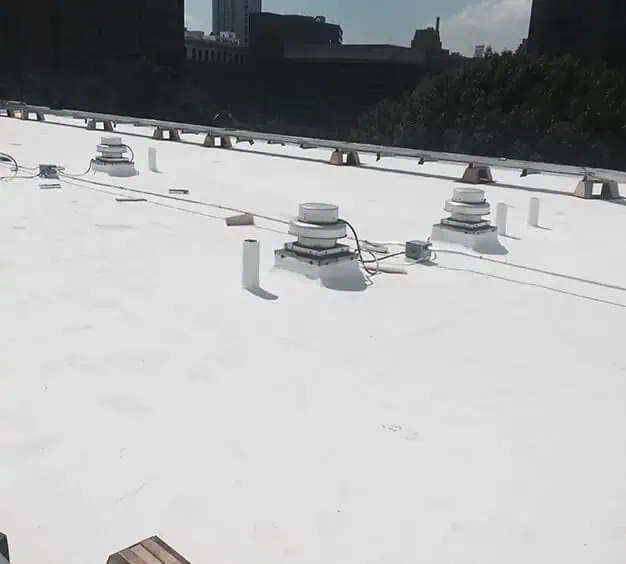Silicone and acrylic roof coatings are two common options for protecting and extending the life of aging commercial roofing membranes, but they have different properties and advantages. Here’s a comparison of silicone and acrylic roof coatings.
Silicone vs. Acrylic Roof Coatings: Material Composition and Application
Silicone roof coatings have a solids content of 90% or greater, meaning less liquid material is used during application to achieve the required dry film thickness. The material is applied using specialized equipment by skilled contractors.
Acrylic roof coatings are water-based and composed of acrylic polymers. Even though an acrylic roof coat is a liquid formulation, it is entirely different from the formulation of acrylic roof paint. Still, it can be applied with a roller or spray equipment.
Silicone vs Acrylic Coatings: Durability
Silicone coatings are typically applied in thick layers, which can help fill in cracks and gaps in the roof surface. They are known for their durability and resistance to weathering, UV rays, and temperature fluctuations. They tend to maintain their elasticity over time.
Acrylic roof coatings also provide excellent durability. They also offer good UV resistance, but acrylic coatings may degrade faster when exposed to prolonged sunlight. Acrylic roof coatings can also become brittle with age in harsh climates.
Silicone Coating System vs Acrylic Roof Coatings: Waterproofing
A silicone roof coating is highly waterproof and prevents water penetration, even on flat roofs.
Acrylic coatings are waterproof but may not perform as well on roofs with poor drainage. Standing water degrades an acrylic roof coating.
Silicone Roof Coatings vs Acrylic Roof Coatings: Cost
A silicone roof coating is generally more expensive than an acrylic coating. However, silicone roof coatings typically have a longer lifespan.
Acrylic coatings are typically more budget-friendly but may require more frequent maintenance and reapplication.
Silicone vs Acrylic Roof Coating: Environmental Factors
Silicone coatings may have a higher environmental impact due to their composition. Proper disposal of waste materials is essential.
However, since acrylic coatings are water-based, they are more environmentally friendly in terms of lower volatile organic compounds emissions and ease of cleanup.
Which Roof Coating System Is Right for Your Commercial Roof Restoration Project?
The choice between silicone and acrylic roof coatings depends on factors such as your budget, the climate in your area, the condition of your roof, and your long-term maintenance plans.
Discuss these choices with that nation’s commercial roofing experts: Nations Roof. We will inspect your property and give the pros and cons of our commercial roof coatings. Fill out the Nations Roof contact form today to schedule a free onsite roof evaluation.
Key Takeaways About Coatings for Commercial Roofing Systems
- There’s much to consider when choosing a suitable coating solution for aging commercial roofing membranes. The two main coating material types are silicone and acrylic.
- Silicone is a thick, durable material that withstands UV rays and resists ponding water. However, silicone systems require expert installation, cost more, and require careful cleanup.
- Acrylic roof coating systems are also durable but don’t stand up as well to standing water. However, acrylic roof coating systems are less expensive, easier to install, and have an easier cleanup.
- Talk to experts in the commercial roof restoration industry to choose between silicone or acrylic coating systems.



